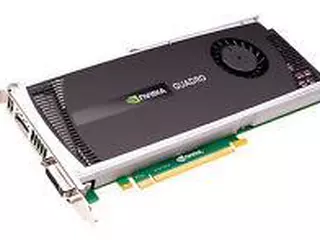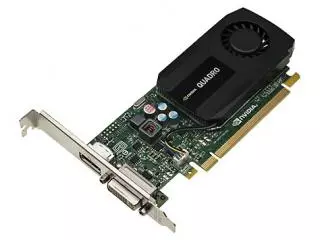Quadro 4000 vs Quadro K420
If you are going to buy a new graphics card and are choosing between Quadro 4000 and Quadro K420, there are a couple of things to consider. Cards with more VRAM in general perform better and allow you to play on higher graphics settings. Size also makes a difference. A model with a large heatsink can occupy up to three expansion slots on a motherboard. Be sure you have enough room in your PC case. When comparing GPUs with different architectures, more processing cores and even higher TFLOPS will not always translate to better performance. To help you decide which GPU you need, we have measured frame rates in a number of popular games. For more on how the Quadro 4000 stacks up against Quadro K420, check out specs charts below.
Main Specs
Quadro 4000
Quadro K420
Power consumption (TDP)
142 Watt
41 Watt
Interface
PCIe 2.0 x16
PCIe 2.0 x16
Supplementary power connectors
1x 6-pin
None
Memory type
GDDR5
128 Bit
Maximum RAM amount
2 GB
1 GB/2 GB
Display Connectors
1x DVI, 2x DisplayPort
1x DVI, 1x DisplayPort
Check Price
Check Price
Quadro 4000 has 246% more power consumption, than Quadro K420.
Both video cards are using PCIe 2.0 x16 interface connection to a motherboard.
Quadro 4000 has 1 GB more memory, than Quadro K420.
Both cards are used in Desktops.
Quadro 4000 is build with Fermi architecture, and Quadro K420 - with Kepler.
Core clock speed of Quadro K420 is 401 MHz higher, than Quadro 4000.
Quadro 4000 is manufactured by 40 nm process technology, and Quadro K420 - by 28 nm process technology.
Quadro 4000 is 81 mm longer, than Quadro K420.
Memory clock speed of Quadro 4000 is 1026 MHz higher, than Quadro K420.
Game benchmarks
Assassin's Creed Odyssey
Battlefield 5
Call of Duty: Warzone
Counter-Strike: Global Offensive
Cyberpunk 2077
Dota 2
Far Cry 5
Fortnite
Forza Horizon 4
Grand Theft Auto V
Metro Exodus
Minecraft
PLAYERUNKNOWN'S BATTLEGROUNDS
Red Dead Redemption 2
The Witcher 3: Wild Hunt
World of Tanks
high / 1080p
6−7
0−1
ultra / 1080p
4−5
0−1
QHD / 1440p
0−1
0−1
low / 720p
16−18
9−10
medium / 1080p
8−9
1−2
The average gaming FPS of Quadro 4000 in Assassin's Creed Odyssey is 140% more, than Quadro K420.
high / 1080p
12−14
−
ultra / 1080p
10−11
1−2
QHD / 1440p
0−1
0−1
low / 720p
24−27
9−10
medium / 1080p
12−14
2−3
The average gaming FPS of Quadro 4000 in Battlefield 5 is 300% more, than Quadro K420.
low / 768p
45−50
50−55
high / 1080p
45−50
45−50
QHD / 1440p
0−1
0−1
The average gaming FPS of Quadro K420 in Call of Duty: Warzone is 6% more, than Quadro 4000.
low / 768p
130−140
100−110
medium / 768p
110−120
75−80
ultra / 1080p
50−55
30−35
QHD / 1440p
27−30
−
4K / 2160p
27−30
9−10
high / 768p
80−85
50−55
The average gaming FPS of Quadro 4000 in Counter-Strike: Global Offensive is 49% more, than Quadro K420.
low / 768p
55−60
70−75
ultra / 1080p
18−20
10−12
medium / 1080p
45−50
45−50
The average gaming FPS of Quadro K420 in Cyberpunk 2077 is 4% more, than Quadro 4000.
low / 768p
80−85
65−70
medium / 768p
60−65
35−40
ultra / 1080p
30−35
14−16
The average gaming FPS of Quadro 4000 in Dota 2 is 47% more, than Quadro K420.
high / 1080p
8−9
1−2
ultra / 1080p
7−8
−
4K / 2160p
3−4
0−1
low / 720p
18−20
7−8
medium / 1080p
9−10
2−3
The average gaming FPS of Quadro 4000 in Far Cry 5 is 300% more, than Quadro K420.
high / 1080p
14−16
−
ultra / 1080p
10−11
−
QHD / 1440p
−
0−1
low / 720p
60−65
40−45
medium / 1080p
21−24
4−5
The average gaming FPS of Quadro 4000 in Fortnite is 82% more, than Quadro K420.
high / 1080p
12−14
1−2
ultra / 1080p
10−12
−
QHD / 1440p
1−2
0−1
low / 720p
24−27
10−12
medium / 1080p
14−16
3−4
The average gaming FPS of Quadro 4000 in Forza Horizon 4 is 240% more, than Quadro K420.
low / 768p
50−55
35−40
medium / 768p
45−50
−
high / 1080p
12−14
1−2
ultra / 1080p
6−7
−
QHD / 1440p
0−1
0−1
medium / 720p
−
30−35
The average gaming FPS of Quadro 4000 in Grand Theft Auto V is 68% more, than Quadro K420.
high / 1080p
5−6
0−1
ultra / 1080p
3−4
0−1
4K / 2160p
0−1
0−1
low / 720p
12−14
1−2
medium / 1080p
6−7
−
The average gaming FPS of Quadro 4000 in Metro Exodus is 1200% more, than Quadro K420.
low / 768p
95−100
85−90
high / 1080p
90−95
50−55
ultra / 1080p
80−85
−
medium / 1080p
90−95
−
The average gaming FPS of Quadro 4000 in Minecraft is 35% more, than Quadro K420.
high / 1080p
16−18
14−16
ultra / 1080p
14−16
12−14
low / 720p
30−35
21−24
medium / 1080p
18−20
14−16
The average gaming FPS of Quadro 4000 in PLAYERUNKNOWN'S BATTLEGROUNDS is 25% more, than Quadro K420.
ultra / 1080p
7−8
−
QHD / 1440p
0−1
0−1
low / 720p
12−14
2−3
medium / 1080p
10−12
−
The average gaming FPS of Quadro 4000 in Red Dead Redemption 2 is 550% more, than Quadro K420.
low / 768p
24−27
4−5
medium / 768p
16−18
−
high / 1080p
9−10
2−3
ultra / 1080p
6−7
−
4K / 2160p
6−7
0−1
The average gaming FPS of Quadro 4000 in The Witcher 3: Wild Hunt is 466% more, than Quadro K420.
low / 768p
85−90
65−70
medium / 768p
45−50
30−35
ultra / 1080p
18−20
10−12
high / 768p
35−40
27−30
The average gaming FPS of Quadro 4000 in World of Tanks is 38% more, than Quadro K420.
Full Specs
Quadro 4000
Quadro K420
Architecture
Fermi
Kepler
Code name
GF100
GK107
Type
Workstation
Workstation
Release date
2 November 2010
22 July 2014
Pipelines
256
192
Core clock speed
475 MHz
876 MHz
Transistor count
3,100 million
1,270 million
Manufacturing process technology
40 nm
28 nm
Texture fill rate
15.20
14.02
Floating-point performance
486.4 gflops
336.4 gflops
Length
241 mm
160 mm
Memory bus width
256 Bit
128 Bit
Memory clock speed
2808 MHz
1782 MHz
Memory bandwidth
89.86 GB/s
DirectX
12 (11_0)
12
Shader Model
5.1
5
OpenGL
4.6
4.5
OpenCL
1.1
1.2
Vulkan
N/A
+
CUDA
2.0
3.0
Bitcoin / BTC (SHA256)
44 Mh/s
11 Mh/s
3D Vision Pro
+
Mosaic
+
Width
1" (2.5 cm)
Number of simultaneous displays
4
nView Desktop Management
+
Check Price
Check Price

